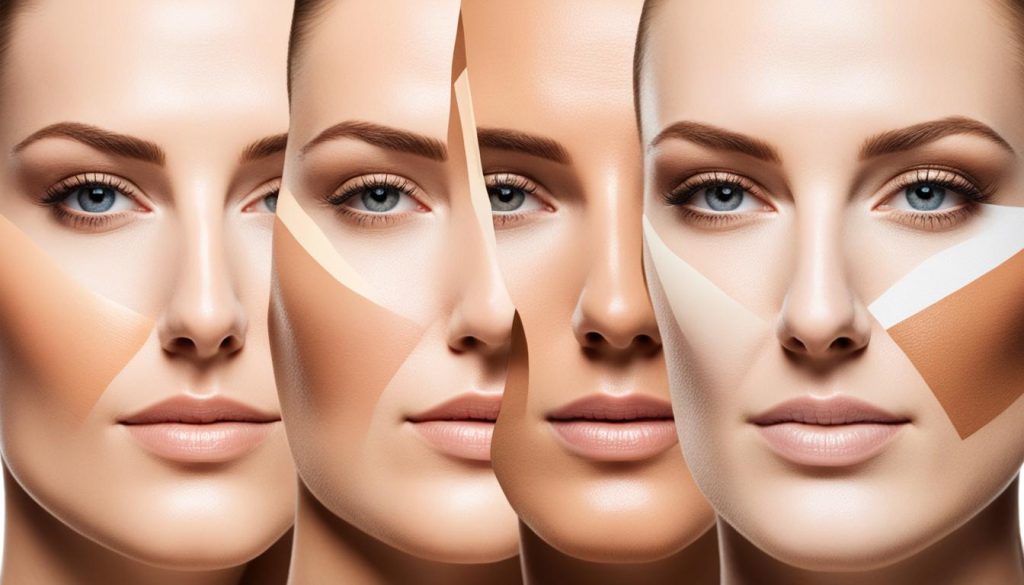L’Oréal Paris has over 40 true-to-skin shades in its True Match Liquid Foundation range. They offer warm, cool, and neutral undertones. This makes finding the perfect foundation easy. Choosing the right foundation is key to a flawless makeup look that boosts your natural beauty.
This guide will help you pick the right foundation for your skin tone and undertone. You’ll feel confident and radiant with the right foundation. We’ll cover how to understand skin tones and the importance of seasonal adjustments.
Get ready to improve your makeup routine and find the best foundation for your skin. Discover the secrets to perfecting your look!
Key Takeaways
- Over 40 shades in L’Oréal Paris True Match Liquid Foundation cater to diverse skin tones.
- Recognizing your undertone is crucial for finding the perfect foundation match.
- Seasonal changes may require adjustments in the foundation shade you choose.
- Testing foundations in natural light helps ensure a better color match.
- L’Oréal Paris offers virtual tools to aid in selecting your foundation shade.
- Understanding skin type can guide you towards the right foundation formula.
- Brands like L’Oréal Paris lead the way in inclusivity, providing a variety of shades.
Understanding Skin Tone and Its Importance
Finding the right foundation starts with knowing your skin tone. It’s the natural color of your skin and comes in four main types: fair, light, medium, and deep. Knowing your skin tone helps pick a foundation that looks good with you.
Defining Skin Tone Categories
Skin tones vary from very fair to very dark. They can be changed by genetics, sun exposure, hormones, and aging. To find your skin tone, look at your jawline for a consistent color. The Fitzpatrick scale can also help by categorizing skin into six types.
| Skin Tone | Description |
|---|---|
| Fair | Very light with possible rosy undertones. |
| Light | Light skin often with warm golden or peachy undertones. |
| Medium | Typical skin tone with a balance of warm and cool undertones. |
| Deep | Dark skin tones can have rich undertones ranging from warm to cool. |
How Skin Tone Affects Foundation Choices
Choosing the right foundation depends on your skin tone. Warm, cool, or neutral undertones affect which foundation shades look best. Warm tones do well with yellow, gold, or peach foundations. Cool tones look good with pink shades. Neutral tones can go for foundations with both gold and pink undertones.
It’s important to test foundation shades on your jawline. This area matches your neck and chest well. Foundation can look different in various lights, so check it in natural light. Your skin tone might change with the seasons, so you might need to switch foundations throughout the year.
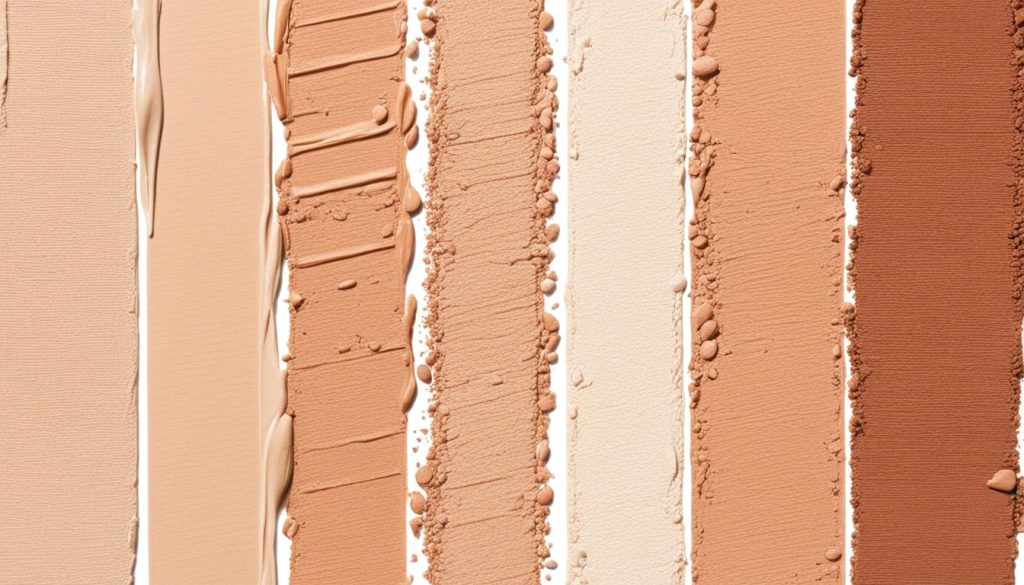
Identifying Your Undertone
Choosing the right foundation means knowing your undertone. Undertones are the subtle colors under your skin. They are key in picking the right foundation shade. There are warm, cool, and neutral undertones. Knowing yours ensures your foundation matches your skin perfectly.
What Are Warm, Cool, and Neutral Undertones?
Warm undertones look peachy or yellow. Cool undertones show pink, red, or blue. Neutral undertones mix both warm and cool, giving you more color options. This affects not just foundation but also clothes and accessories. For example, warm undertones look great with yellow gold jewelry, while cool ones do well with silver or platinum.
Simple Tests to Determine Your Undertone
Here are easy ways to find your undertone:
- Vein color test: Look at the veins under your wrist. Greenish veins mean warm undertones, and blue or purplish veins suggest cool undertones.
- Jewelry preference: Yellow gold suits warm undertones, and silver is better for cool ones.
- Sun reaction: Burning easily might mean cool undertones, while tanning easily suggests warm undertones.
- Fabric method: Pure white fabric makes warm undertones pop, while it can wash out cool undertones.
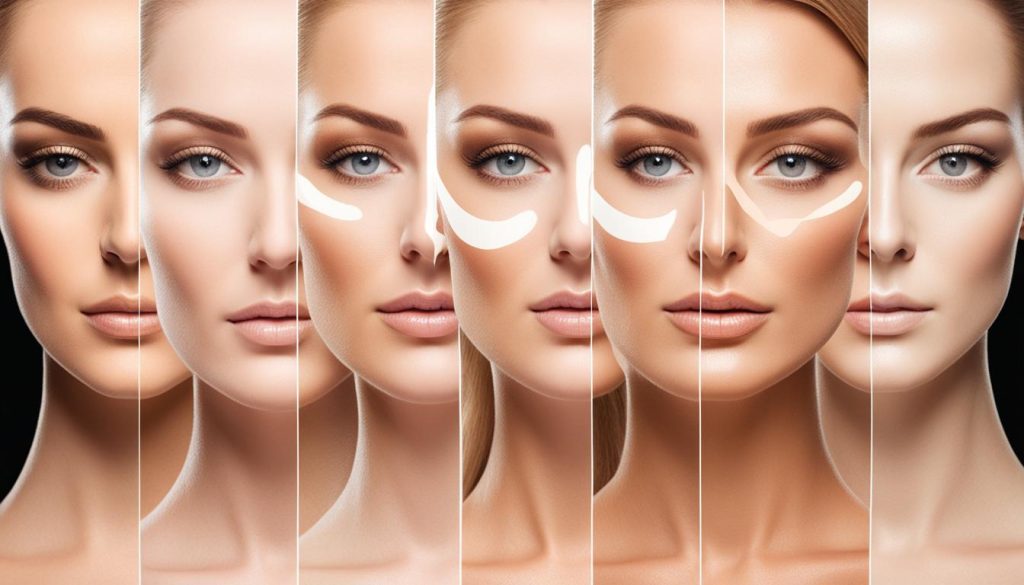
Once you know your undertone, picking the right foundation is easier. Cool undertones work well with pinkish foundations, while warm ones suit yellow-based formulas. Neutral undertones can go with either. Finding your undertone opens up a world of better makeup choices and improves your look.
How to Choose the Right Foundation for Your Skin Tone
Finding the perfect foundation is more than just picking a color. It’s about matching shades to your skin tone and considering your undertone. This approach helps in choosing makeup for skin tone that boosts your natural beauty and gives you a flawless look.
Matching Foundation Shades to Your Skin Tone
It’s key to find the right foundation shade for a seamless look. There are light, medium, and dark skin tones, each with various shades to fit individual tastes. Begin by testing shades along your jawline to find the best match. Brands like L’Oréal Paris True Match use a clear system, labeling shades as ‘C’ for cool, ‘W’ for warm, and ‘N’ for neutral. This makes picking the right shade easier.
The Role of Undertones in Foundation Selection
After finding your skin tone, look at your undertone, which can be warm, cool, or neutral. This greatly impacts how the foundation looks on you. Warm undertones have golden or peachy colors, while cool ones have blue or pink. Neutral undertones mix both warm and cool tones. Choosing the right foundation means considering these undertones for a natural look.
To test undertones, try the jewelry test or the vein test. Gold looks good on warm undertones, and silver on cool ones. Quality foundations provide long-lasting coverage, making them key for your makeup routine.
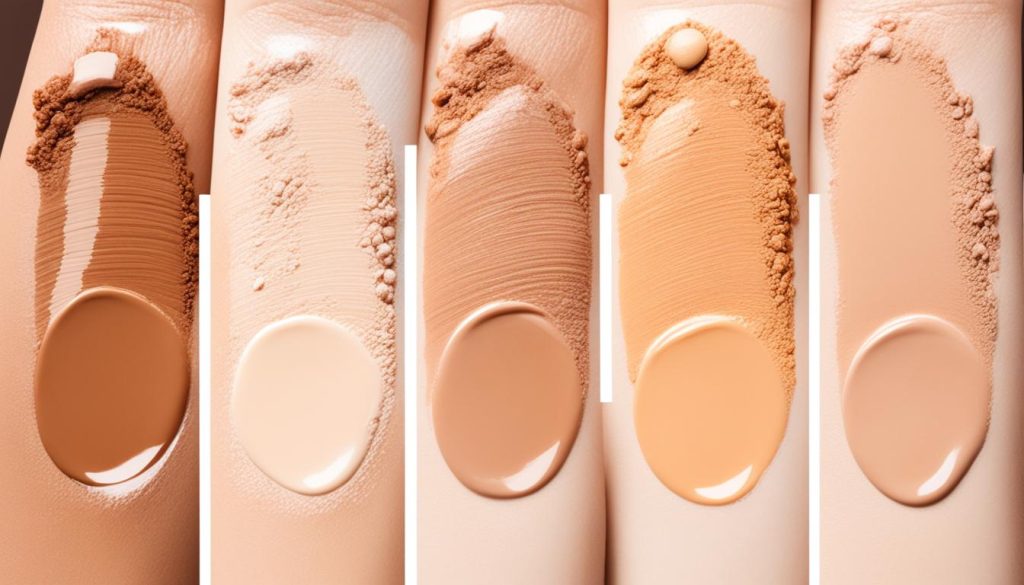
| Undertone Type | Description | Foundation Match Suggestions |
|---|---|---|
| Warm | Golden or peachy hues | L’Oréal True Match W shades |
| Cool | Blue or pink tones | Fenty Beauty Pro Filt’r in cool shades |
| Neutral | Mix of warm and cool | Estée Lauder Double Wear Neutral shades |
Choosing the right foundation means thinking about your skin tone and undertone. Knowing your unique mix helps you get a look that’s just for you.
Testing Foundation Shades Effectively
Finding the right foundation shade is all about testing. Apply foundation shades directly on bare skin to see how they look with your natural color. This is key to matching foundation with your skin tone well.
How to Swatch Foundation on Your Skin
Put a few foundation shades along your jawline, blending from cheek to neck. This makes sure your face and neck look the same. Don’t test on your arm, as it can look different from your face.
Try three different shades before buying to see which suits you best. If you’re still unsure, beauty counter experts can help match colors to your skin. They offer free color-matching services to find the right shade for you.
Importance of Testing in Natural Light
Testing foundation shades in natural light is crucial. Indoor lights can change how the foundation looks, leading to wrong choices. Test during the day, like at 11:00 am or 2:00 pm, when the light is steady.
Try out different shades and types at home in a well-lit spot by a window. This makes choosing easier and less stressful. It helps avoid missing the undertones, which affect how your foundation looks.
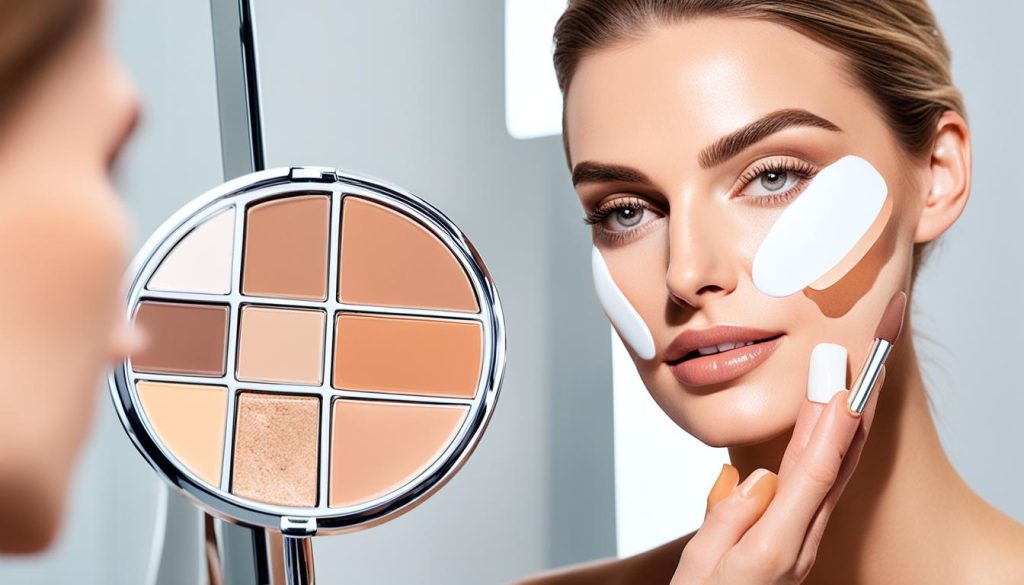
Seasonal Changes and Foundation Matching
Seasonal changes affect our skin tone, making it key to adjust your foundation. Your skin changes with the weather, so what works in summer might not in winter.
Adjusting Your Foundation for Different Seasons
In summer, the sun makes our skin darker. Those with warm undertones look more golden or peachy. They need foundations with orange and gold in them.
Winter makes our skin lighter. This means we might need foundations with cooler undertones. These have red and pink bases.
How Weather Affects Your Skin Tone and Undertone
Weather changes not just our skin’s surface but also its undertone. People with neutral undertones can use a variety of foundations all year. Apollo Barragan suggests adding SPF to your foundation in hot months for protection.
Jenna Menard says picking a foundation that matches your neck and chest is key. This avoids harsh lines.
Applying foundation on clean, dry skin with a primer is crucial. Use brushes or damp sponges for a smooth look. Sometimes, a duo fiber brush or a damp sponge gives a light foundation layer without too much product.
Selecting the Right Foundation Formula
Finding the right foundation is key to a perfect look. There are many formulas for different skin types. This ensures comfort and boosts your natural beauty. Think about your skin type when picking a foundation.
Understanding Different Foundation Formulas
Foundation types differ in texture, coverage, and finish. These differences affect how your makeup looks. Here are some common ones:
- Liquid Foundations: Great for most skin types, offering various coverage levels.
- Cream Foundations: Provide heavy coverage, great for special events.
- Powder Foundations: Ideal for oily skin, controls oil and keeps skin matte.
- Hydrating Formulas: Perfect for dry skin, adds moisture for a dewy look.
- Matte Foundations: Best for oily skin, stays on all day.
Choosing Based on Skin Type: Oily, Dry, or Combination
Choosing the right foundation also depends on your skin type. Here are some tips for different skin types:
| Skin Type | Recommended Formula | Foundation Examples |
|---|---|---|
| Oily | Matte or Powder | Bare Minerals Barepro Powder Foundation |
| Dry | Hydrating or Cream | Nars Sheer Glow Foundation |
| Combination | Balanced Formula | Ilia Super Serum Skin Tint |
Knowing your undertone is important when picking foundation. Whether your skin has warm, cool, or neutral undertones matters. This helps find a foundation that blends well with your skin for a natural look. Experts suggest trying out shades to find the perfect match along your jawline, enhancing your appearance.
The Impact of Skin Texture on Foundation Choice
Skin texture greatly affects how foundation looks and stays on all day. People with different skin types need specific foundations that match their skin well. Knowing how skin texture and foundation work together helps find the best match for your skin tone.
Foundation Recommendations for Various Skin Textures
If you have dry or aging skin, look for hydrating foundations with a dewy finish. They add moisture and shine. Here are some top picks:
- Hydrating Foundations: Tarte’s Amazonian Clay Foundation nourishes while offering coverage.
- Matte Foundations: Fenty Beauty’s Pro Filt’r Soft Matte Longwear Foundation is great for oily skin, controlling shine.
- Formulations for Textured Skin: Laura Mercier’s Tinted Moisturizer smooths out uneven skin without caking.
Choosing the right formula is key for comfort and looks all day. It’s important to match your foundation to your skin type for the best look.
How Aging Affects Foundation Choices
When you’re getting older, picking the right foundation is crucial. Look for light coverage with moisturizing properties to avoid settling into fine lines. Keep these tips in mind:
| Foundation Type | Benefits |
|---|---|
| Tinted Moisturizer | Light coverage with hydration |
| BB Cream | Skin nourishing ingredients for a natural look |
| CC Cream | Color correcting features alongside hydration |
Trying out different foundations may help you find the best one for your skin tone. It should look good and hide imperfections well. The right foundation can also improve your skin’s health and look.
Utilizing Virtual Tools for Foundation Matching
Technology has changed how we pick foundation shades, making it easy and fun. Now, virtual tools help us find our perfect match without the hassle of old-school shopping.
Overview of Virtual Shade Matching Tools
Virtual tools use new tech to give personalized shade advice. Brands like L’Oréal Paris use the Monk Skin Tone Scale for a wide range of skin tones. This makes shopping easier and helps customers find their perfect match with more confidence.
Popular Beauty Brands Offering Virtual Consultations
Big names like L’Oréal Paris and Charlotte Tilbury now offer virtual consultations. L’Oréal Paris has a wide range of products, including the True Match Super-Blendable Foundation in 47 shades. They also have the Infallible 24 Hour Fresh Wear Foundation in 30 shades.
Other platforms like Findation help users find the right foundation across various brands. The Lava Arts Foundation Color Match Quiz gives insights to help customers pick a good shade. These tools also offer virtual try-ons, letting people test shades with photos or webcams to skip the guesswork.
Using these virtual tools boosts customer happiness and builds brand loyalty. Brands that focus on skin tone finders understand what customers want better. They can improve their products and make customers happy with a wide range of options that match their skin tones.
Finding Inclusive Brands for Diverse Skin Tones
Beauty brands that include everyone are key to making sure everyone finds products that match their skin. Many brands now offer a wide range of shades. This lets people from all backgrounds feel seen in the beauty world.
Brands Known for Wide Shade Ranges
Some beauty brands are known for their big shade ranges:
- Fenty Beauty: The Pro Filt’r Soft Matte Longwear Foundation has 40 shades for all skin tones.
- MAC Studio Fix Fluid Foundation: With 43 shades, it focuses on light and medium tones but has fewer options for medium-dark and dark skin.
- Kylie Cosmetics: The Skin Concealer line has 30 shades, covering a wide range but missing some medium-dark options.
- Rare Beauty: Started by Selena Gomez, this brand is open about its shade development, working to be inclusive.
- Maybelline Fit Me: It keeps adding new shades based on what customers want, aiming to serve diverse consumers.
The Importance of Inclusivity in Beauty Products
Listening to a wide range of customers helps brands make products that really connect. When brands focus on inclusivity, they:
- Gain trust and loyalty from customers.
- Open up new market chances by reaching groups that were left out before.
- Boost their reputation by showing a real commitment to showing everyone.
Inclusive beauty brands not only meet what customers want but also show the diverse world we live in. They highlight the need to think about different undertones and shades. This way, everyone can find their ideal foundation.
Conclusion
Finding the right foundation is key to a flawless look. It’s important to know how to pick the best one for your skin tone. By understanding your skin’s tone and undertone, you can easily find the right shades.
Most brands offer 20 to 30 shades, designed for various skin types and undertones. This means there’s a match for everyone. Testing shades in natural light is crucial because colors look different under various lights.
Tools like virtual shade matching or expert consultations can help you find the perfect product. For example, the SÉRY foundation range has options for different skin types. Each one has special benefits, like SPF for sun protection.
With a wide range of shades for cool, warm, and neutral undertones, everyone can find a foundation that suits their skin. Use the right techniques and products to feel confident in your skin.
FAQ
How do I determine my skin tone?
Look at the color of your complexion near your jawline. You can be fair, light, medium, or deep. Remember, your skin tone can change with the seasons.
What is the difference between skin tone and undertone?
Skin tone is the main color of your skin. Undertone is the deeper color you can’t see easily. It can be warm (yellow/peachy), cool (pink/red), or neutral (a mix).
How can I find the right foundation shade for my skin tone?
Try different foundation shades on your jawline. Pick the one that blends well with your skin. Always check in natural light for the best match.
Does my undertone affect my foundation choice?
Yes, your undertone is key to finding the right foundation. It should match your undertone for a natural look. Look for cool, warm, or neutral labels on foundations.
How should I test foundation shades effectively?
Apply foundation from cheek to neck along your jawline. Don’t test on your arm, as it may not match your face. Always check in natural light.
Can my foundation shade change with the seasons?
Yes! Your skin tone can change with the seasons. In summer, you might get darker from the sun. In winter, you might get lighter. Adjust your foundation shade as needed.
What different foundation formulas should I consider?
There are many formulas for different skin types and needs. Liquid foundations are versatile, cream foundations offer more coverage, and powder foundations are great for oily skin. Choose what suits you best.
How does skin texture impact foundation selection?
Your skin texture changes how foundation looks on you. For dry or aging skin, go for hydrating formulas. Oily skin does well with matte finishes. Textured skin benefits from smoothing formulas.
Are there virtual tools to help in finding my foundation shade?
Yes, many brands have virtual tools and quizzes. Charlotte Tilbury and Huda Beauty offer personalized recommendations. These tools help you find your perfect foundation match.
Which makeup brands are known for their inclusivity in shades?
Fenty Beauty, Bobbi Brown, and Estee Lauder lead in offering a wide range of foundation shades. They make sure everyone can find a foundation that suits them.


